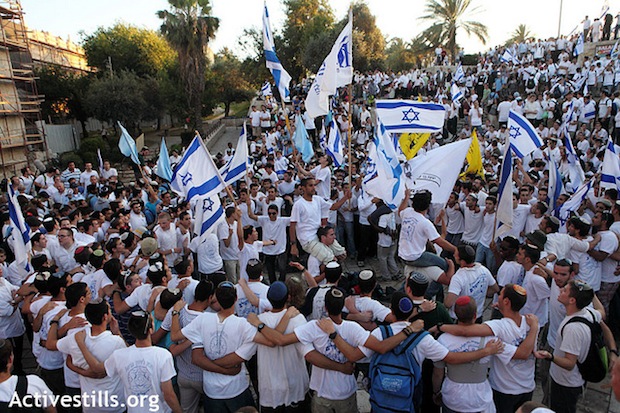Whether in Area C of the West Bank, in the Negev, the Galilee or the ‘mixed cities,’ Regavim has one clear goal: the selective implementation of planning and construction laws, encouraging the state to demolish Palestinian homes or public buildings.
By Rona Moran and Miryam Wijler
It all began one bright morning in April, after reading an outrageous op-ed by the right-wing journalist Karni Eldad [Hebrew] about Dahamash – an “unrecognized” village in the Ramle-Lod area that we hold quite dear. Karni Eldad’s text can be summed up as a pathetic attempt at comparing the status of Jewish settlements and outposts in the Occupied Palestinian Territories with the state of unrecognized villages within the 1948 borders. The date of publication was no coincidence, coming just a few days before a meeting of the Ministry of Interior’s Borders Committee regarding the future of the village. After the initial rage abated somewhat, we sat down to write a response and turned to Arafat Ismail, chairman of the village committee, to help us confirm all of the legal details.
Arafat told us that Eldad’s article is actually a one-to-one reproduction of arguments that an association named Regavim had presented to various planning committees against recognizing the village. Though this was our first encounter with the association, it has been almost ubiquitous ever since – from the halls of the High Court of Justice down to the village of Al Zarnoug (where Regavim conducted a tour that was interrupted by Knesset Member Talab Al-Sana), from the Knesset committees to the planning commission meetings. They seem to be gaining power and racking up achievements, so we thought we should get to know them a bit more in depth.
Regavim’s goals and strategy
The association’s website is a good starting point. The site’s home page presents the association’s main goal – promoting a Jewish and Zionist agenda for the State of Israel on issues of land and environment, or as they put it: “safeguarding the lands of the Nation.”
Such statements are familiar from the agenda of Gush Emunim (a Jewish organization dedicated to settling in the West Bank and Gaza Strip since 1967), not to mention the fundamental tenets of the Zionist movement since its inception. However, we see Regavim as part of a new phase in the evolution of the national-religious right in Israel, which has traditionally sought to expand Jewish control and ownership of lands in historic Palestine by settling Jewish Israelis on lands in the Occupied Palestinian Territories. This movement enjoys the full support of the state and all its institutions in the pursuit of its mission. Regavim employs a complementary strategy that focuses on “enforcement.” Instead of encouraging Jewish settlement supported by the state, the association exerts pressure on the authorities to escalate processes of dispossession by blocking any horizons for development of the country’s Palestinian inhabitants. The association rejects the strategy of land redemption through the donations of private persons overseas, and wishes to “influence all governing systems of the State, make them act in light of Zionism’s ground principles and fulfill them in actual fact, to preserve the lands of the Jewish People…preventing their takeover by foreign elements.”
Betzal’el Smotrich, activities director of the association, presents Regavim as a mirror image of human rights organizations in Israel. The guiding rationale of those organizations is action towards policy-change and the righting of specific “wrongs” through a combination of legal resources, research, lobbying and campaigning. Regavim has adopted these practices, and at times even some of their rhetoric, in order to promote a lands policy that is based on absolute preference in allotting lands to Jews.
Regavim’s activities
Regavim does not deal with settling the land with Jewish Israelis, but rather with the expulsion of the Palestinian population on both sides of the Green Line. The association is active in Area C of the West Bank, in the Negev, the Galilee and the “mixed cities.” In all of these arenas, Regavim has one clear goal: the brutal and selective implementation of planning and construction laws, encouraging the state to demolish Palestinian homes or public buildings. The demolition orders issued lately for the entire Palestinian village of Susya in the South Hebron Hills are the fruit of its labors.
In recent years, since the Israeli disengagement in the Gaza Strip and the dismantling of the settlements there, the extreme right in Israel has embarked on a campaign of settling the “mixed cities” of Israel (cities with sizable Arab and Jewish populations) by forming “Torah clusters” (Garinim Toraniim) – in Jaffa, Acco as well as Lod. At the same time, Jewish nationalist shows of force have escalated within Arab localities. Regavim is a characteristic expression of this wider campaign. It takes a considerable amount of cruelty to encourage the state to tighten even further the veritable noose of planning restrictions around the neck of Palestinian communities within the Green Line. Palestinian citizens of Israel own a very small percentage of the lands they had owned before 1948, most of their localities do not have master zoning plans, and the local and regional planning committees are staffed exclusively by Jewish Israelis.

The situation in the Negev is even worse: there the state doesn’t even recognize the Bedouins’ claim to any land while promoting a plan that is expected to result in the uprooting of 30,000 people and the erasure of their villages. The State of Israel has left this population in a legal limbo that makes it impossible to live: people cannot build on their land, cannot purchase land belonging to the Jewish National Fund, will not be accepted as members of Jewish communities due to screening committees, and most Jewish Israeli towns’ residents will not rent or sell them apartments. All that is left, for people who will not choose to emigrate, would be illegal construction. The state prefers that its Palestinians subjects be “criminals.”
Regavim’s activity is based first and foremost on the work of coordinators on the ground, who systematically document construction in Palestinian communities. This documentation serves the association in lobbying planning committees, local authorities, the Civil Administration in the occupied territories, and others. They have a single demand: to force these institutions to place sanctions on Palestinians. In some cases, the association appeals to court in order to force the implementation of standing demolition orders, or to produce a planning policy that is as Zionist as possible. Regavim promotes existing transfer plans such as its efforts to influence the Prawer Committee recommendations to take a harder line against the Bedouin community.
In April 2009, Regavim sued the Abu Basma Regional Council in the Negev, where the number of inhabitants in all known localities in the council’s area is about 45,000, but in fact the council provides services to another 35,000 citizens who live in unrecognized villages. The council ranks dead last in the socio-economic scale of the Israeli Central Bureau of Statistics and where the council is not providing inhabitants within its jurisdiction area with the most basic services: connection to the water supply grid, regular garbage collection, sanitation infrastructure, and where access roads are not paved and the council’s welfare services are collapsing.
Here, of all places, is where the Regavim association suddenly discovered an urgent need to intervene “for the sake of the council’s inhabitants.” In its petition, the association demands the demolition of eight structures, which describes as “villas” and whose owners it describes as “real estate barons.” For Regavim, then, they have no qualms about using whatever means necessary to “protect the nation’s lands.” To that end, they encourage the state to beat to a pulp its most oppressed population.
The diplomatic face of the ideological-messianic right
Regavim presents a “nicer” or at least more diplomatic face of a trend that began within the settler community following the disengagement from Gaza. The failure of the resistance to the disengagement brought about the creation of another movement – “Komemiyut” (independence), whose goal is “enhancing Jewish uprightness as a central national idea in the State of Israel, reinforcing Jewish settlement and thwarting intentions to expel Jews.”
Among the rabbis of this movement is Dov Lior, rabbi of Kiryat Arba (the largest Jewish settlement in Hebron) and one of the leaders who expressed public support for the book Torat Hamelech (“The King’s Torah”). Another is Rabbi Haim Yerucham Smotrich, of Beit Yatir (Jewish settlement in the South Hebron Hills), father of Betzal’el Smotrich, one of Regavim’s leaders, operations director of the association and an active member of Komemiyut.
Though Regavim did adopt the channels of legal action used by human rights organizations, it did not adopt the liberal ideology upon which legal activism is based. A closer look at the ideology of the association’s leaders and of their ties with other right-wing organizations reveals that their choice of the legal path is instrumental and tactical only. In an article published by Smotrich in Gilui Da’at, the most popular weekend supplement in the national-religious public, following the High Court of Justice’s ruling on Migron, Smotrich objects to what he defines as “High Court rule,” contests the court’s authority to rule on issues regarding the future of the settlement project, and marks the Knesset as the sole legitimate arena for discussion of such issues.
In an article published by Rabbi Yehuda Eliyahu, the association’s director, in Komemiyut’s publication, he outlines an ideal Jewish state, one that lacks any liberal values whatsoever. In his writing, Eliyahu presents the Jewish National Fund as a body that undermined the very purpose for which it was founded – redeeming the land for the Jewish people. He accuses the Fund of corruption, which he blames on the “post-Zionist spirit” of the High Court of Justice and resents the court’s ruling demanding that the Israel Land Administration administer JNF lands according to the principle of equality, allotting some of them to Arabs as well.
In an interview, Smotrich explains: “I see the State of Israel as the beginning of our redemption, and as an important phase on the way to complete salvation. But unlike many who adhere to state norms, I do not consider myself a slave of the system nor a fifth wheel on the regime’s wagon. I believe we are perfectly entitled to quarrel with the present coachman and take the reins into our own hands by means available to us.” He spoke of the warm welcome which Regavim feels from the state apparatus – “on the ground and in many departments of the Ministry of Interior, the Israel Land Administration, the Ministry of Justice etc., Regavim is regarded as a positive element whose aim is to help them meet the pressure exerted by the left.”
Compared to other new, ideologically related right-wing movements such as Im Tirtzu, Regavim has so far remained relatively anonymous among leftist activists, except for the lawyers who run into its representatives in the courtroom. Both Regavim and Im Tirtzu represent the values of the ideological right with an easy-to-digest package for the Israeli mainstream. But while Im Tirtzu is basically an advocacy organization, Regavim urges the state rather than the public to manifest its neo-Zionist vision in practice. An adequate response to this campaign will not come from small, focused victories in court, important though they may be, but rather in the public arena and through political struggle.
Rona Moran and Miryam Wijler are activists in the Hithabrut-Tarabut Movement, an Arab-Jewish movement for social and political change. This post was translated by Tal Haran.

